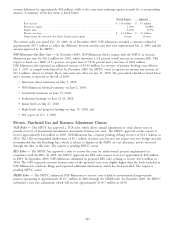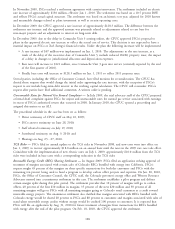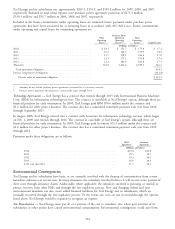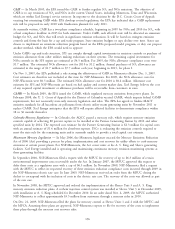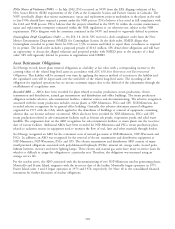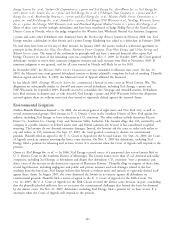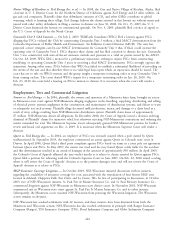Xcel Energy 2009 Annual Report Download - page 142
Download and view the complete annual report
Please find page 142 of the 2009 Xcel Energy annual report below. You can navigate through the pages in the report by either clicking on the pages listed below, or by using the keyword search tool below to find specific information within the annual report.17. Commitments and Contingent Liabilities
Commitments
Capital Commitments — As of Dec. 31, 2009, the estimated cost of capital requirements of Xcel Energy and its
subsidiaries and the capital expenditure programs is approximately $2.2 billion in 2010, $2.3 billion in 2011 and
$2.1 billion in 2012. Xcel Energy’s capital forecast includes the following major projects:
Nuclear Capacity Increases and Life Extension — NSP-Minnesota is seeking a 20-year license renewal for the Monticello
and Prairie Island nuclear plants. A renewed operating license was approved and issued for Monticello by the NRC in
November 2006 licensing the plant to operate until 2030, and the MPUC order approving the spent fuel storage
capacity needed to support plant operations until 2030 went into effect in June 2007. The application to renew Prairie
Island’s operating licenses was submitted to the NRC in April 2008 and the application for a CON for additional spent
fuel storage capacity to support 20 additional years of plant operation was approved by the MPUC in December 2009.
Final state and federal approvals are expected in 2010.
NSP-Minnesota is pursuing capacity increases of Monticello and Prairie Island that will total approximately 235 MW,
to be implemented, if approved, between 2010 and 2015. The life extension and capacity increase for Prairie Island
Unit 2 is contingent on replacement of Unit 2’s original steam generators, currently planned during the refueling outage
in 2013. Total capital investment for these activities is estimated to be over $1 billion between 2010 and 2015.
NSP-Minnesota submitted the CON and site permit applications for Monticello’s power uprate in the first quarter of
2008 and the CON and site permit applications for Prairie Island’s power uprate in the second quarter of 2008. The
MPUC approved the Monticello power uprate CON and site permit in December 2008 and the Prairie Island power
uprate CON and site permit in December 2009.
Wind Generation — NSP-Minnesota is investing approximately $900 million over three years for a 201 MW project in
southwestern Minnesota, called the Nobles Wind Project, and a 150 MW project in southeastern North Dakota, called
the Merricourt Wind Project. These projects are expected to be operational by the end of 2010 and 2011, respectively.
NSP-Minnesota has received regulatory approval for the projects, and has requested recovery of eligible costs beginning
in 2010.
CapX 2020 — In 2006, CapX 2020, an alliance of electric cooperatives, municipals and investor-owned utilities in the
upper Midwest, including Xcel Energy, announced that it had identified several groups of transmission projects that
proposed to be complete by 2020. Group 1 project investments are expected to total approximately $1.7 billion, with
major construction targeted to begin in 2010 and ending three to five years later. Xcel Energy’s investment is expected
to be approximately $900 million depending on the route and configuration approved by the MPUC and the PSCW.
Approximately 75 percent of the 2010 capital expenditures and return on investment for transmission projects are
expected to be recovered under an NSP-Minnesota TCR tariff rider mechanism authorized by Minnesota legislation, as
well as a similar TCR mechanism passed in South Dakota. Cost-recovery by NSP-Wisconsin is expected to occur
through the biennial PSCW rate case process.
The capital expenditure programs of Xcel Energy are subject to continuing review and modification. Actual utility
construction expenditures may vary from the estimates due to changes in electric and natural gas projected load growth
regulatory decisions, the desired reserve margin and the availability of purchased power, as well as alternative plans for
meeting Xcel Energy’s long-term energy needs. In addition, Xcel Energy’s ongoing evaluation of compliance with future
requirements to install emission-control equipment, and merger, acquisition and divestiture opportunities to support
corporate strategies may impact actual capital requirements.
Fuel Contracts — Xcel Energy and its subsidiaries have contracts providing for the purchase and delivery of a
significant portion of its current coal, nuclear fuel and natural gas requirements. These contracts expire in various years
between 2010 and 2040. In total, Xcel Energy is committed to the minimum purchase of approximately $2.3 billion of
coal, $598.3 million of nuclear fuel and $4.4 billion of natural gas, including $3.3 billion of natural gas storage and
transportation, or to make payments in lieu thereof, under these contracts. In addition, Xcel Energy is required to pay
additional amounts depending on actual quantities shipped under these agreements. Xcel Energy’s risk of loss, in the
form of increased costs from market price changes in fuel, is mitigated through the use of natural gas and energy cost
rate adjustment mechanisms, which provide for pass-through of most fuel, storage and transportation costs to
customers.
Purchased Power Agreements — The utility subsidiaries of Xcel Energy have entered into agreements with utilities and
other energy suppliers for purchased power to meet system load and energy requirements, replace generation from
company-owned units under maintenance and during outages, and meet operating reserve obligations. NSP-Minnesota,
132



